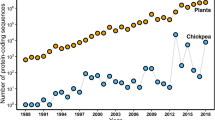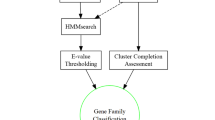Abstract
In the course of evolution, the genomes of grasses have maintained an observable degree of gene order conservation. The information available for already sequenced genomes can be used to predict the gene order of nonsequenced species by means of comparative colinearity studies. The “Wheat Zapper” application presented here performs on-demand colinearity analysis between wheat, rice, Sorghum, and Brachypodium in a simple, time efficient, and flexible manner. This application was specifically designed to provide plant scientists with a set of tools, comprising not only synteny inference, but also automated primer design, intron/exon boundaries prediction, visual representation using the graphic tool Circos 0.53, and the possibility of downloading FASTA sequences for downstream applications. Quality of the “Wheat Zapper” prediction was confirmed against the genome of maize, with good correlation (r > 0.83) observed between the gene order predicted on the basis of synteny and their actual position on the genome. Further, the accuracy of “Wheat Zapper” was calculated at 0.65 considering the “Genome Zipper” application as the “gold” standard. The differences between these two tools are amply discussed, making the point that “Wheat Zapper” is an accurate and reliable on-demand tool that is sure to benefit the cereal scientific community. The Wheat Zapper is available at http://wge.ndsu.nodak.edu/wheatzapper/.



Similar content being viewed by others
Abbreviations
- EST:
-
Expressed sequence tags
- Brachypodium :
-
Brachypodium distachyon
- TC:
-
Tentative consensus sequence
- WZ:
-
Wheat Zapper
- GZ:
-
Genome Zipper
- BLAST:
-
Basic Local Alignment Search Tool
- BLASTn:
-
Basic Local Alignment Search Tool for nucleotides
References
Abrouk M, Murat F, Pont C et al (2010) Paleogenomics of plants: synteny-based modeling of extinct ancestors. Trends Plant Sci 15(9):479–487
Bolot S, Abrouk M, Masood-Quraishi et al (2009) The ‘inner circle’ of the cereal genomes. Curr Opin Plant Biol 12:119–125
Brenchley R, Spannagl M, Pfeifer M et al (2012) Analysis of the bread wheat genome using whole-genome shotgun sequencing. Nature 491:705–710
Dolezel J, Kubalakova M, Paux E, Bartos J, Feuillet C (2007) Chromosome-based genomics in cereals. Chromosome Res 15:51–66
Faris JD, Gill BS (2002) Genome targeting and high-resolution mapping of the domestication gene Q in wheat. Genome 45:706–718
Faris JD, Fellers JP, Brooks SA, Gill BS (2003) A bacterial artificial chromosome contig spanning the major domestication locus Q in wheat and identification of a candidate gene. Genetics 164:311–321
Feuillet C, Stein N, Rossini L et al (2012) Integrating cereal genomics to support innovation in the Triticeae. Funct Integr Genomics 12:573–583
Food and Agriculture Organization (2010) FAO Statistical Year Book 2010. Rome, Italy, FAO
Gill KS, Gill BS, Endo TR, Boyko EV (1996) Identification and high-density mapping of gene-rich regions in chromosome group 5 of wheat. Genetics 143:1001–1012
Goodstein DM, Shu S, Howson R et al (2011) Phytozome: a comparative platform for green plant genomics. Nucleic Acids Res 40(D1):D1178–D1186
Hernandez P, Martis M, Dorado G et al (2012) Next-generation sequencing and syntenic integration of flow-sorted arms of wheat chromosome 4A exposes the chromosome structure and gene content. Plant J 69:377–386
International Rice Genome Sequencing Project (2005) The map-based sequence of the rice genome. Nature 436:793–800
Krattinger S, Wicker T, Keller B (2009) Map-based cloning of genes in Triticeae (wheat and barley). In: Feuillet C, Muehlbauer GJ (eds) Genetics and genomics of the Triticeae. Springer, New York, pp 337–358
Krzywinski MI, Schein J, Bitol I et al (2009) Circos: an information aesthetic for comparative genomics. Genome Res 19(9):1639–1645
Liang F, Holt I, Pertea G et al (2000) An optimized protocol for analysis of EST sequences. Nucleic Acids Res 28:3657–3665
Luo MC, Deal KR, Akhunov ED et al (2009) Genome comparisons reveal a dominant mechanism of chromosome number reduction in grasses and accelerated genome evolution in Triticeae. Proc Nat Acad Sc 106:15780–15785
Mayer KFX, Martis M, Hedley PE et al (2011) Unlocking the barley genome by chromosomal and comparative genomics. Plant Cell 23(4):1249–1263
Michalak de Jimenez M, Bassi FM, Ghavami F et al (2013) Radiation hybrid map of chromosome 1D reveals synteny conservation at a wheat speciation locus. Funct Integr Genomics ADJOIN PAPER
Ouyang S, Zhu W, Hamilton J et al (2007) The TIGR Rice Genome Annotation Resource: improvements and new features. Nucl Acids Res 35:D846–D851
Paterson AH, Bowers JE, Bruggman R et al (2009) The Sorghum bicolor genome and the diversification of grasses. Nature 457:551–556
Paux E, Sourdille P, Salse J et al (2008) A physical map of the 1-gigabase bread wheat chromosome 3B. Science 322:101–104
Quraishi UM, Abrouk M, Murat F et al (2011) Cross-genome map based dissection of a nitrogen use efficiency ortho-meta QTL in bread wheat unravels concerted cereal genome evolution. Plant J 65:745–756
Salse J, Bolot S, Throude M et al (2008) Identification and characterization of shared duplications between rice and wheat provide new insight into grass genome evolution. Plant Cell 20:11–24
Salvi S, Tuberosa R (2005) To clone or not to clone plant QTLs: present and future challenges. Trends Plant Sci 10(6):1360–1385
Schnable PS, Ware D, Fulton RS et al (2009) The B73 maize genome: complexity, diversity, and dynamics. Science 326:1112–1115
Schnurbusch T, Collins NC, Eastwood RF et al (2007) Fine mapping and targeted SNP survey using rice–wheat gene colinearity in the region of the Bo1 boron toxicity tolerance locus of bread wheat. Theor Appl Genet 115:451–461
Springer NM, Ying K, Fu Y et al (2009) Maize inbreds exhibit high levels of copy number variation (CNV) and presence/absence variation (PAV) in genome content. PLoS Genet 5(11):e1000734
Swigonova Z, Lai J, Ramakrishna W, Llaca V, Bennetzen JL, Messing J (2004) Close split of sorghum and maize genome progenitors. Genome Res 14:1916–1923
Terracciano I, Maccaferri M, Bassi F et al (2013) Development of COS-SNP and HRM markers for high-throughput and reliable haplotype-based detection of Lr14a in durum wheat (Triticum durum Desf.). Theor Appl Genet. doi:10.1007/s00122-012-2038-9
The International Brachypodium Initiative (2010) Genome sequencing and analysis of the model grass Brachypodium distachyon. Nature 463:763–768
Untergasser A, Nijveen H, Rao X et al (2007) Primer3Plus, an enhanced web interface to Primer3. Nucleic Acids Res 35:W71–W74
Vitulo N, Albiero A, Forcato C et al (2011) First survey of the wheat chromosome 5A composition through a next generation sequencing approach. PLoS One 6(10):e26421
Acknowledgments
The authors wish to thank all our beta testers for very insightful suggestions. This work was supported by funding from the National Science Foundation, Plant Genome Research Program (NSF-PGRP) grant no. IOS-0822100 to SFK. FMB was partially supported by Program Master and Back Regione Autonoma della Sardegna and Monsanto Beachell-Borlaug International Scholarship.
Author information
Authors and Affiliations
Corresponding author
Additional information
Loai M. Alnemer, Raed I. Seetan, and Filippo M. Bassi contributed equally to this paper.
Electronic supplementary material
Supplementary information provides a precise description of the Intron/Exon prediction algorithm and data supporting the evaluation of ‘Wheat Zapper’ against the genome of maize (Fig. S1 and Table S1).
ESM 1
DOCX 31 kb
Table S2
Spread sheet for the evaluation of synteny prediction calculated by ‘Wheat Zapper’. a Provides a comparison between the predictions of ‘Wheat Zapper’ and ‘Genome Zipper’ for the synteny relationships between Brachypodium, Sorghum, and wheat chromosome 5A. b Provides a list of orthologus genes predicted to be located within the Q gene interval, including the causal locus (highlighted in green; (XLSX 22 kb)
Rights and permissions
About this article
Cite this article
Alnemer, L.M., Seetan, R.I., Bassi, F.M. et al. Wheat Zapper: a flexible online tool for colinearity studies in grass genomes. Funct Integr Genomics 13, 11–17 (2013). https://doi.org/10.1007/s10142-013-0317-4
Received:
Revised:
Accepted:
Published:
Issue Date:
DOI: https://doi.org/10.1007/s10142-013-0317-4




